What are macronutrients and micronutrients
There’s no denying the impact food has on health. Eating high quality foods is essential in nourishing the body and protecting it from inflammation and oxidative stress.1 An inadequate intake of nutrients in your diet can lead to anything from low energy levels to chronic disease and serious health conditions.2 Having an awareness and understanding of the different types of nutrients in foods, the effects they have on your body, and how to incorporate them into your diet, makes it easier to live a healthy, balanced lifestyle.3
Macro and micronutrients
The nutrients your body needs to promote growth and development and regulate bodily processes can be divided into two groups: macronutrients and micronutrients. Macronutrients are the nutrients your body needs in larger amounts, namely carbohydrates, protein, and fat.4 These provide your body with energy, or calories. Micronutrients are the nutrients your body needs in smaller amounts, which are commonly referred to as vitamins and minerals.5
We need macronutrients to help with energy and we need micronutrients to help our body be healthy and digest those macronutrients.6
Doctor Donald Hensrud, the Mayo Clinic
Working together, both macro and micronutrients provide your body with what it needs to be healthy. A more in-depth look into the roles and functions they support in your body is discussed below.
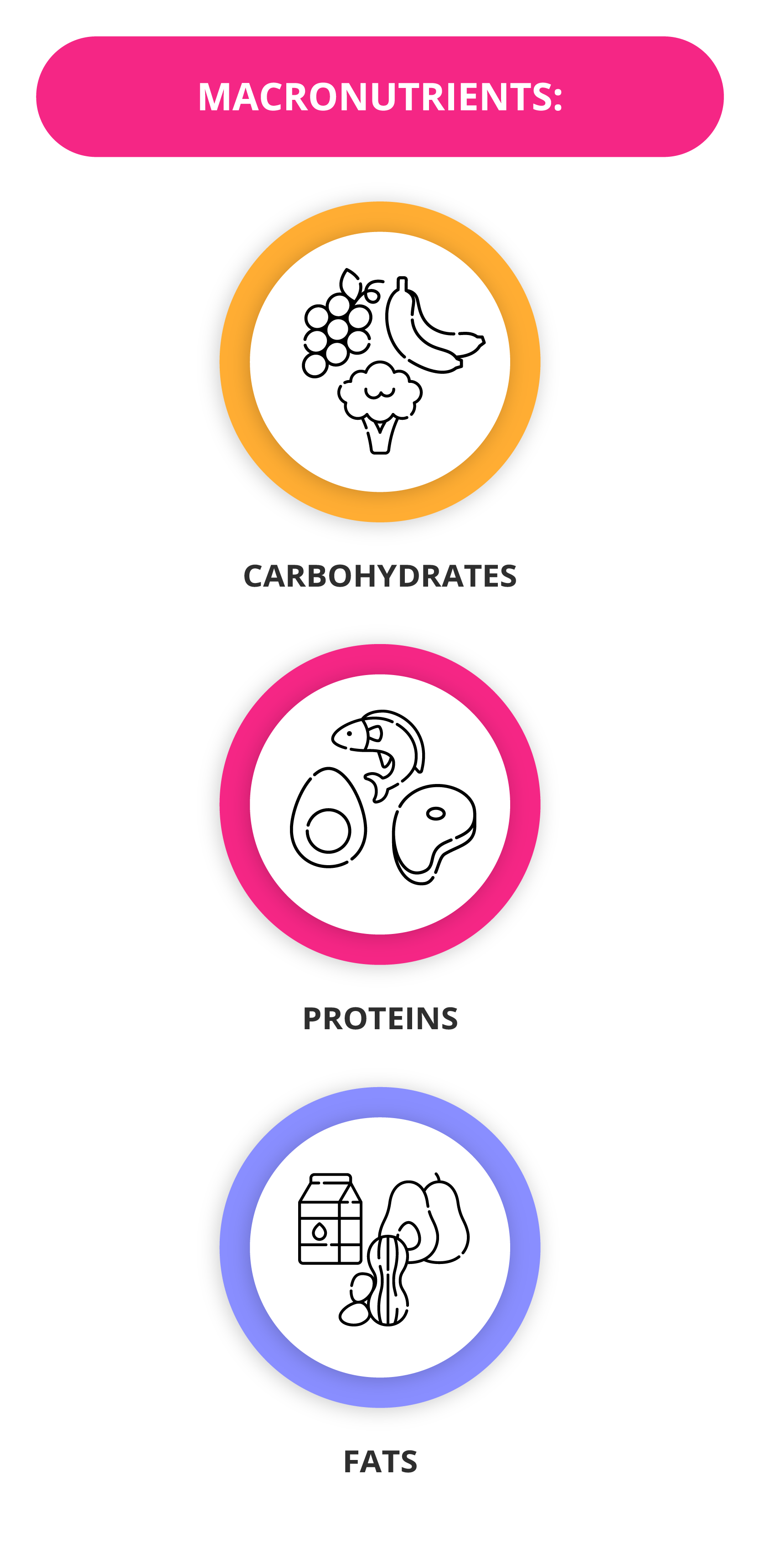
Macronutrients are the elements in food that you need to grow and function normally. All macronutrients are obtained through the diet as the body can’t produce them on its own.7 Carbohydrates, protein, and fat are the three main suppliers of nutrition in your diet. While all macros provide valuable energy to your body, they each fulfil different functions.8

Carbohydrates are the sugars, starches and fibers found in fruits, grains, and vegetables. They’re the most important source of quick energy in your diet because they’re easily broken down into glucose, which the muscles and brain use to function.9 While carbs are found in healthy foods like vegetables, they’re also found in unhealthy foods like cakes and doughnuts, which has given them a bad reputation in various diets. The important distinction to make in this instance is between simple and complex carbohydrates.10 The difference between the two is the chemical structure which affects how quickly the sugar is absorbed by the body.11 Simple carbs, or ‘bad’ carbs, generally release sugar faster because they are made with processed and refined sugar and don’t contain any vitamins, minerals, or fibers.12 Complex, or ‘good carbs’, are processed more slowly and are filled with various nutrients.13
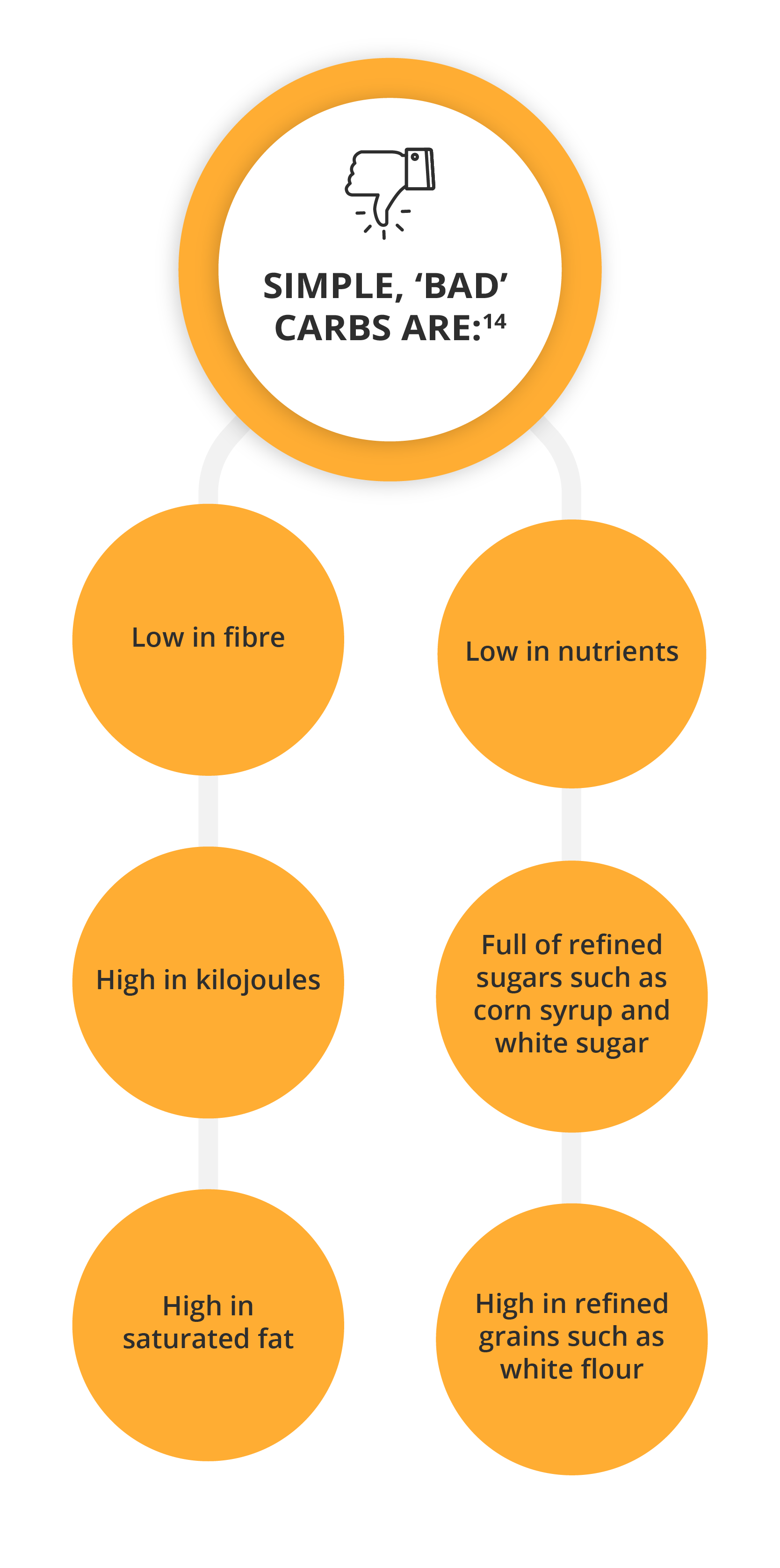
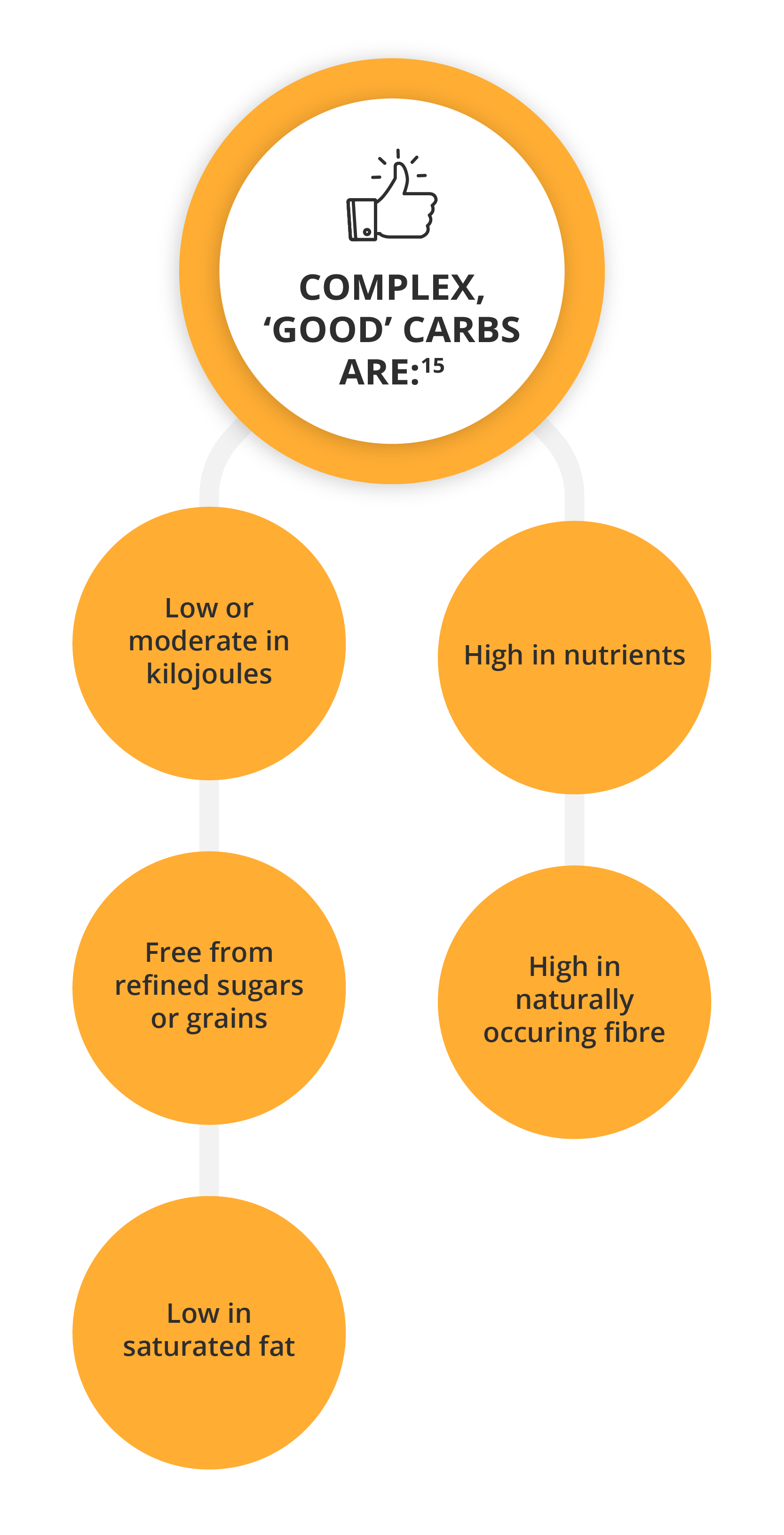
Your daily intake of carbs will depend on various, personal considerations.16 However, when you do eat them, it’s important to choose the most energy and nutrient dense sources of carbohydrates.
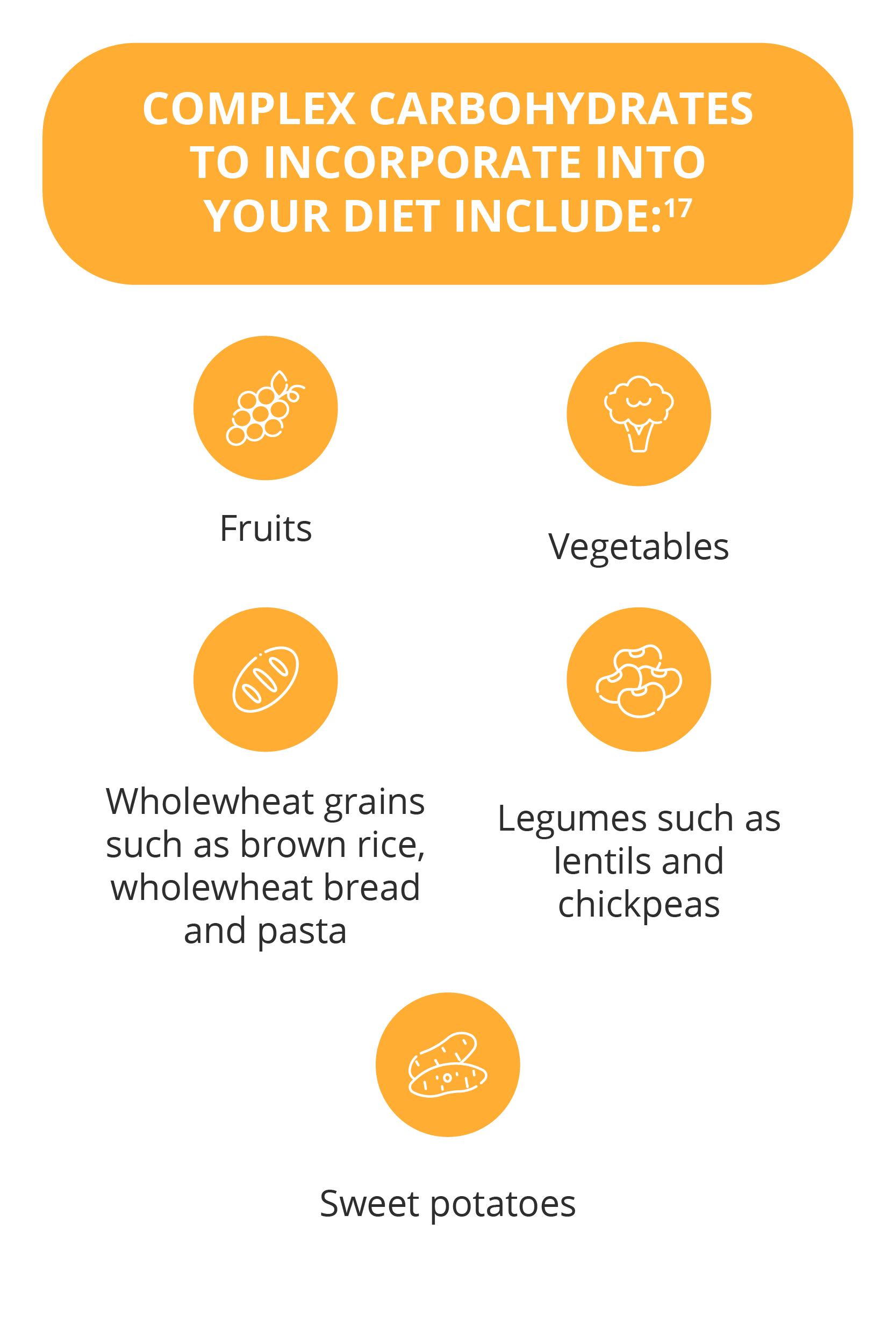

Proteins are made up of amino acids and function as hormones, enzymes, and an antibody in the immune system.18 They make up parts of bodily structures like connective tissues, skin, hair, and muscle fibres.19 Unlike carbs, proteins don’t serve as a direct source of energy, but work like building blocks for other structures in the body. The nutritional value of a protein is measured by the quantity of essential amino acids that it contains, which varies depending on the food source.20
Animal products, such as meat and fish, contain all of the essential amino acids. Soy products, quinoa, and the seeds of a leafy green called Amaranth also contain all of the essential amino acids.21 Plant proteins usually lack at least one amino acid, so eating a combination of different plant proteins throughout the day is important for vegetarians and vegans.22
The recommended daily intake of protein is between 0.75 grams and 1 gram per kilogram of your body weight.23
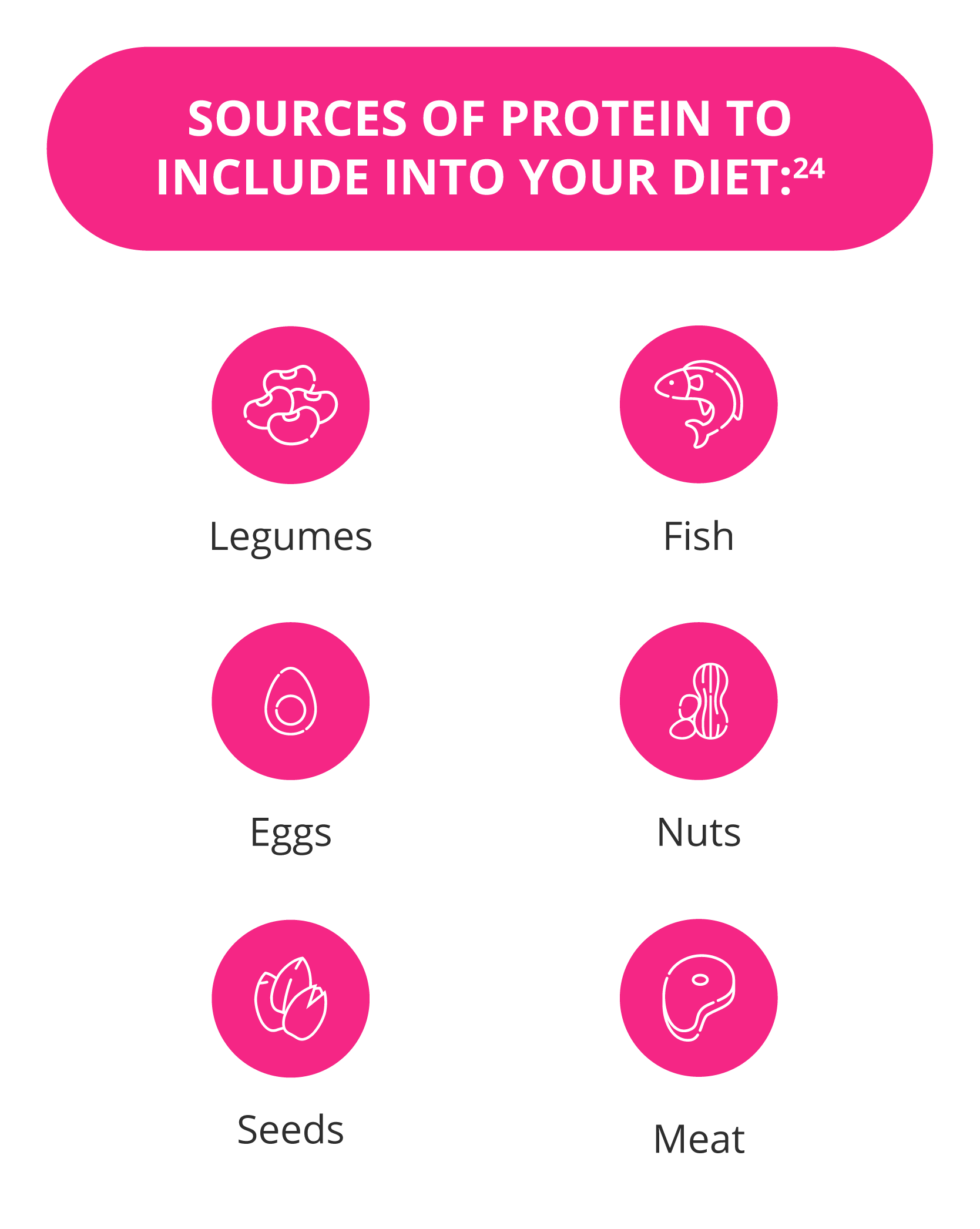

The distinction between saturated and unsaturated fats is important because your body only needs the latter.25 Unsaturated fats regulate metabolism, maintain the elasticity of cell membranes, improve blood flow, and promote cell growth and regeneration. Fats are also important in delivering fat-soluble vitamins A, D, E and K into the body.26
While your body doesn’t necessarily need saturated fats, they do provide your body with cholesterol, which plays an important role in hormone production. Your body does produce its own cholesterol, but a small amount introduced through your diet can help build cell membranes, produce hormones like oestrogen and testosterone, help your metabolism work, produce vitamin D, and produce bile acids which help digest fat and absorb nutrients.27 However, a diet rich in cholesterol can increase the risk of heart disease.28
Fats should make up between 30–35 per cent of your daily caloric intake, with a maximum of 10 per cent of that being saturated fats.29
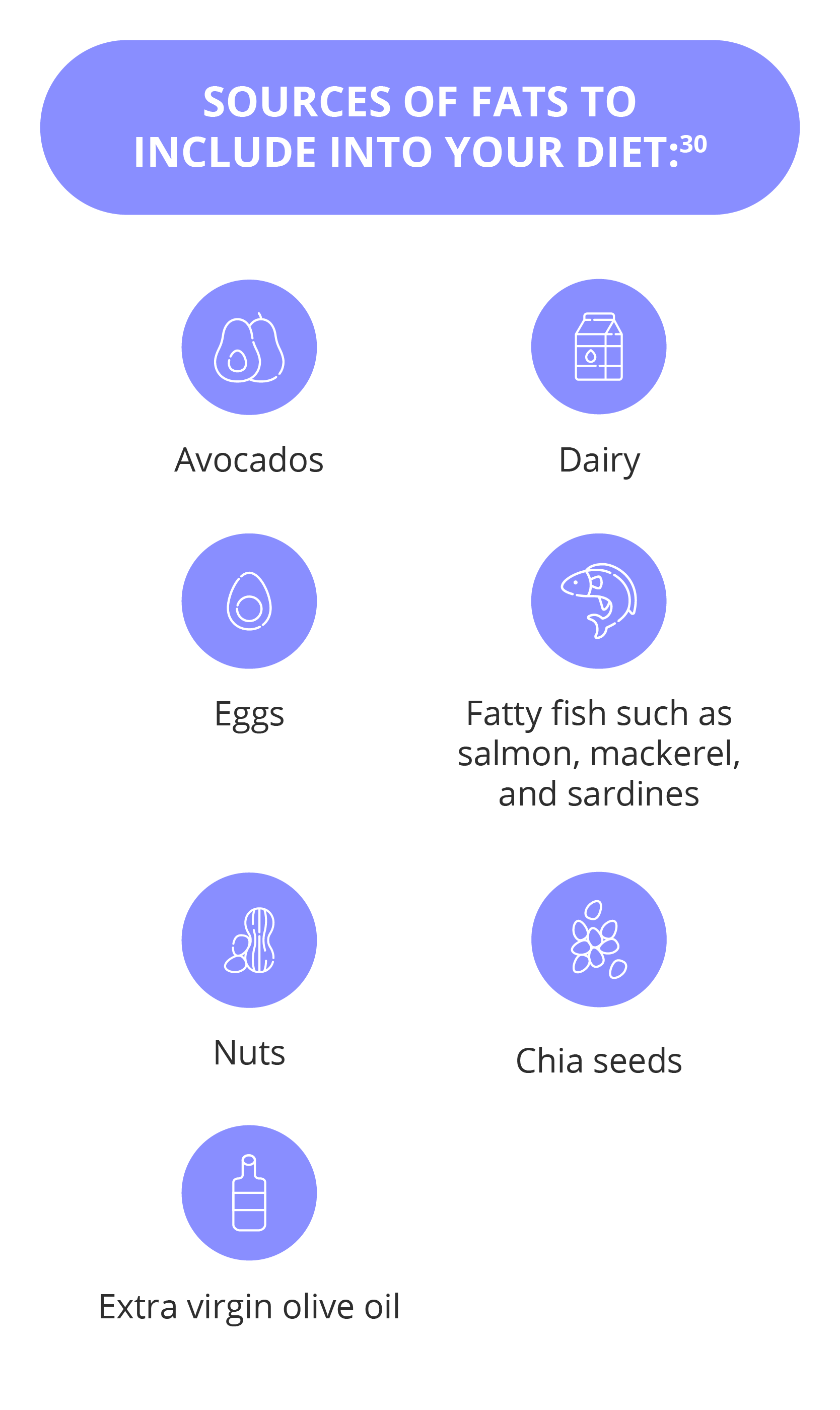
It’s clear that many of the foods in each group overlap, and each macro fulfills a crucial role in your overall health. A balanced diet with the appropriate amount and ratio of macronutrients is vital for a healthy body and mind.
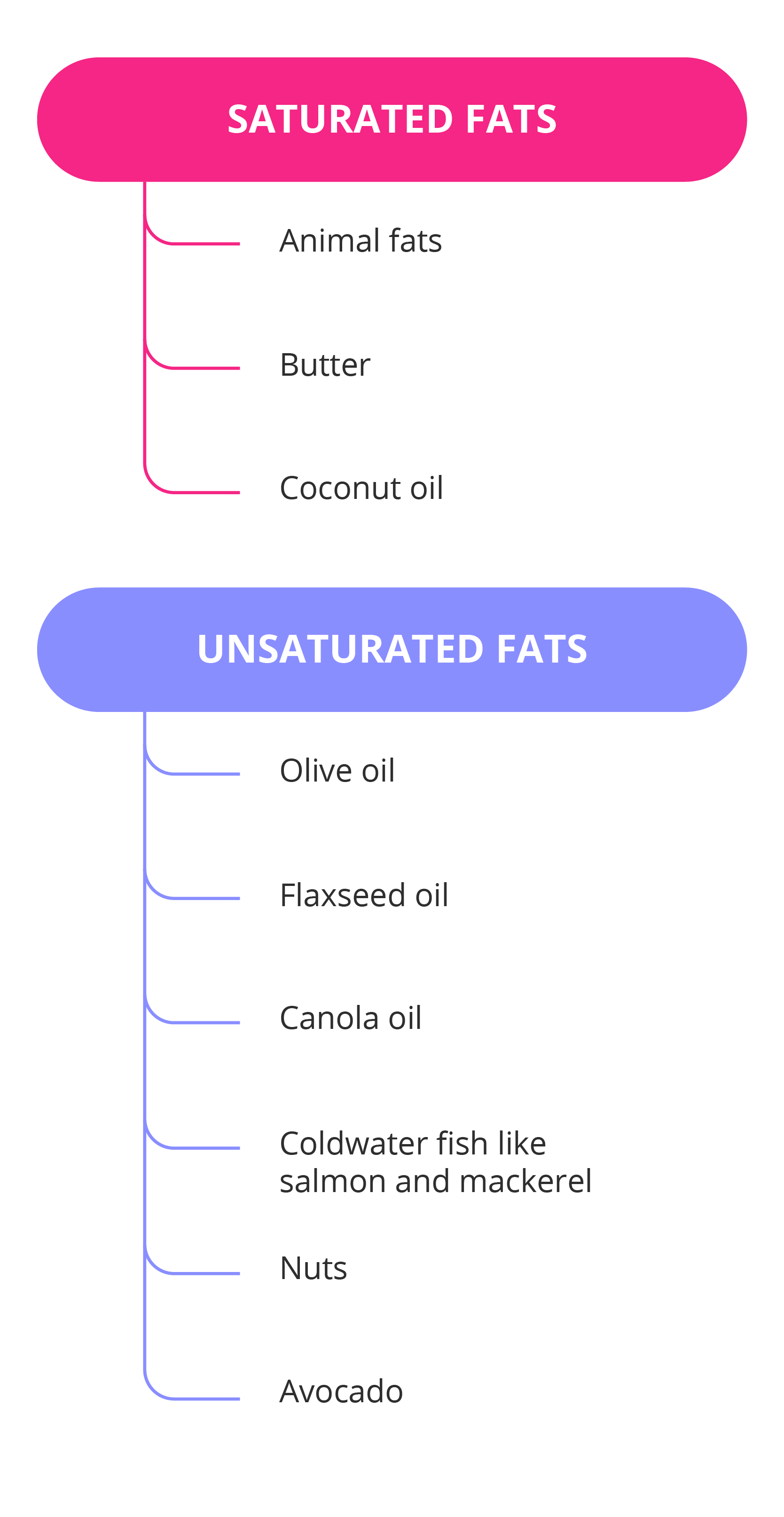
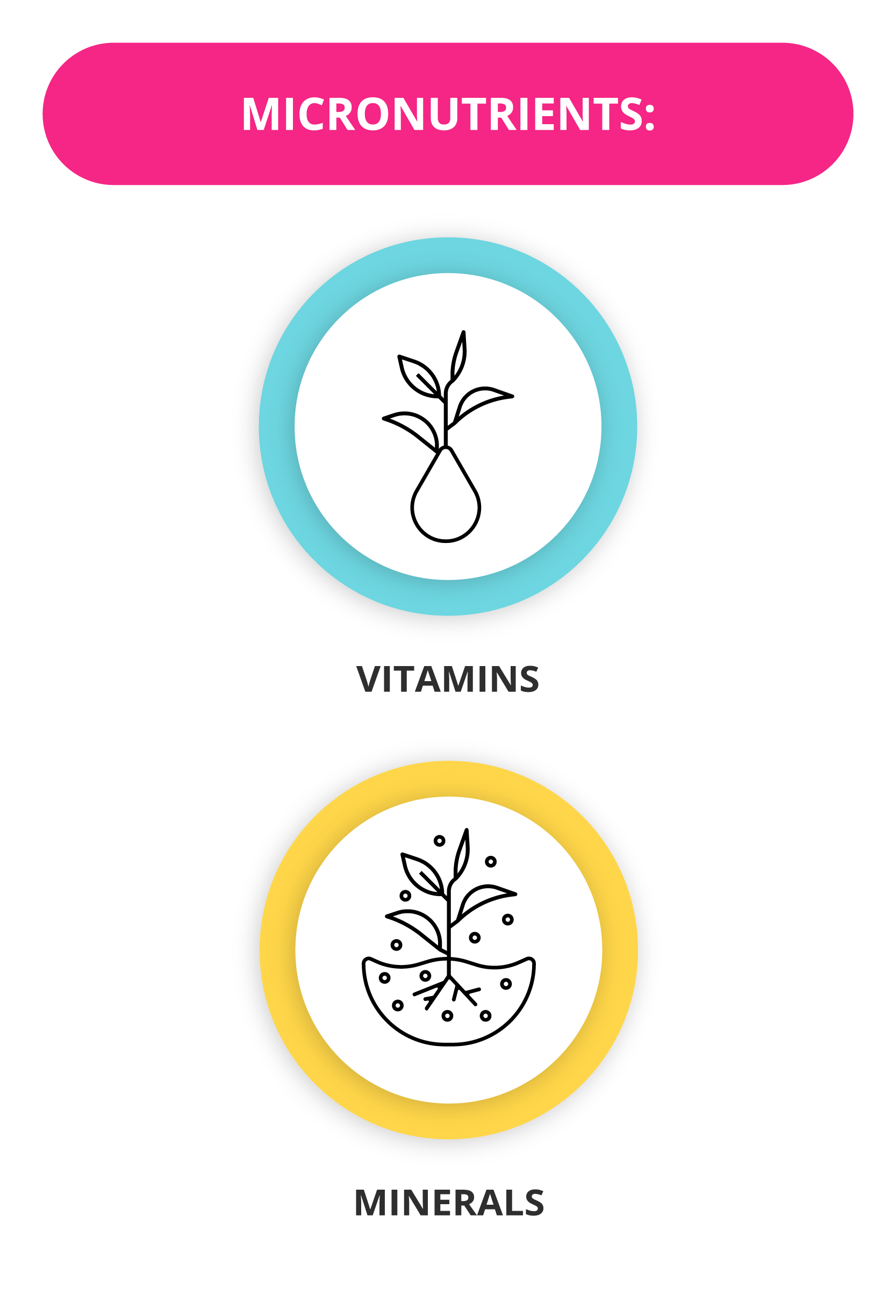
Like macronutrients, your body doesn’t produce micronutrients in the quantities that it needs, so eating a diet rich in vitamins and minerals is essential for a healthy body.31 Vitamins are organic and can be broken down by elements such as heat, air, or acid – which means they can denature when cooked or exposed to air, making it slightly more difficult to ensure you’re getting them in your diet.32 Minerals on the other hand are inorganic and aren’t broken down in this way. This means that your body absorbs the minerals in the soil and water your food has come from.33
Each vitamin and mineral has a specific role in your body, and the best way to ensure you’re meeting all your bodily needs is by eating a healthy, varied diet. Not only are micronutrients crucial for nearly every process in your body, they can also act as antioxidants.34 In the right quantity, they protect your body against disease and deficiencies. Eating a balanced diet promotes this and improves your chances of getting a variety of minerals and vitamins through your food into your bloodstream. While they work together, vitamins and minerals have different tasks in the body.

- One of the main functions of vitamins is to help release the energy found in the food that you eat
- Vitamins help build protein and help your cells multiply
- They make collagen, which helps heal wounds, support blood vessel walls, and promote healthy bones and teeth
- Vitamins keep your eyes, skin, lungs, digestive tract and nervous system in good condition
- They build your bones, protect your vision, and interact with each other to help your body absorb the vitamins it needs to
- They protect you against diseases

- Minerals maintain the correct balance of water in your body
- They promote healthy bones and stabilise the protein structures that you get from the protein you eat, including those that make up your hair, skin, and nails
- They get the oxygen moving around your body
- Minerals assist in your ability to taste and smell

There are multiple food items that fulfil both macro and micronutrient functions. Incorporating these foods into your diet will allow your body to function at an optimal level. Other than oxygen and water, the food you eat is the only input your body has to perform the functions it needs for you to go about your daily life. The better quality the input, the better your body will be able to function and perform.
Understand the science behind what you eat for a healthier body with the Nutrition Science online short course from the Stanford Center for Health Education (SCHE).
- 1 Selhub, E. (Apr, 2018). ‘Nutritional psychiatry: Your brain on food’. Retrieved from Harvard Health Publishing.
- 2 Satrazemis, E. (Jan, 2017). ‘Macro and micronutrients’. Retrieved from Trifecta.
- 3 (Aug, 2017). ‘What makes up a healthy balanced diet?’ Retrieved from MacMillan Cancer Support.
- 4 (Nd). ‘Nutrition basics’. Retrieved from Washington State University. Accessed 13 June 2019.
- 5 (Nd). ‘Nutrition basics’. Retrieved from Washington State University. Accessed 13 June 2019.
- 6 Roth, I. (Apr, 2018). ‘Mayo clinic minute: The difference between micronutrients and macronutrients’. Retrieved from Mayo Clinic.
- 7 Szalay, J. (Jul, 2017). ‘What are carbohydrates?’ Retrieved from Live Science.
- 8 Runtastic Team. (Nov, 2018). ‘What are macronutrients? Everything you need to know’. Retrieved from Runtastic.
- 9 Satrazemis, E. (Jan, 2017). ‘Macro and micronutrients’. Retrieved from Trifecta.
- 10 Szalay, J. (Jul, 2017). ‘What are carbohydrates?’ Retrieved from Live Science.
- 11 Szalay, J. (Jul, 2017). ‘What are carbohydrates?’ Retrieved from Live Science.
- 12 Szalay, J. (Jul, 2017). ‘What are carbohydrates?’ Retrieved from Live Science.
- 13 Szalay, J. (Jul, 2017). ‘What are carbohydrates?’ Retrieved from Live Science.
- 14 Szalay, J. (Jul, 2017). ‘What are carbohydrates?’ Retrieved from Live Science.
- 15 Szalay, J. (Jul, 2017). ‘What are carbohydrates?’ Retrieved from Live Science.
- 16 Gunnars, K. (Jan, 2018). ‘How many carbs should you eat per day to lose weight?’ Retrieved from Healthline.
- 17 Runtastic Team. (Nov, 2018). ‘What are macronutrients? Everything you need to know’. Retrieved from Runtastic.
- 18 Runtastic Team. (Nov, 2018). ‘What are macronutrients? Everything you need to know’. Retrieved from Runtastic.
- 19 Runtastic Team. (Nov, 2018). ‘What are macronutrients? Everything you need to know’. Retrieved from Runtastic.
- 20 (Nd). ‘Proteins’. Retrieved from Better Health. Accessed 14 June 2019.
- 21 (Nd). ‘Proteins’. Retrieved from Better Health. Accessed 14 June 2019.
- 22 (Nd). ‘Proteins’. Retrieved from Better Health. Accessed 14 June 2019.
- 23 Runtastic Team. (Nov, 2018). ‘What are macronutrients? Everything you need to know’. Retrieved from Runtastic.
- 24 Runtastic Team. (Nov, 2018). ‘What are macronutrients? Everything you need to know’. Retrieved from Runtastic.
- 25 Runtastic Team. (Nov, 2018). ‘What are macronutrients? Everything you need to know’. Retrieved from Runtastic.
- 26 Runtastic Team. (Nov, 2018). ‘What are macronutrients? Everything you need to know’. Retrieved from Runtastic.
- 27 (Nd). ‘Cholesterol’. Retrieved from Better Health. Accessed 14 June 2019.
- 28 (Nd). ‘Cholesterol’. Retrieved from Better Health. Accessed 14 June 2019.
- 29 Runtastic Team. (Nov, 2018). ‘What are macronutrients? Everything you need to know’. Retrieved from Runtastic.
- 30 Gunnars, K. (Jun, 2017). ‘10 high-fat foods that are actually super healthy’. Retrieved from Healthline.
- 31 Streit, L. (Sep, 2018). ‘Micronutrients: Types, functions, benefits, and more’. Retrieved from Healthline.
- 32 (2019). ‘Vitamins and Minerals: Are you getting what you need?’ Retrieved from Help Guide.
- 33 (2019). ‘Vitamins and Minerals: Are you getting what you need?’ Retrieved from Help Guide.
- 34 Streit, L. (Sep, 2018). ‘Micronutrients: Types, functions, benefits, and more’. Retrieved from Healthline.
- 35 (2019). ‘Vitamins and Minerals: Are you getting what you need?’ Retrieved from Help Guide.
- 36 (2019). ‘Vitamins and Minerals: Are you getting what you need?’ Retrieved from Help Guide.
- 37 (Apr, 2018). ‘Getting your vitamins and minerals through diet’. Retrieved from Harvard Health Publishing, Harvard Medical School.